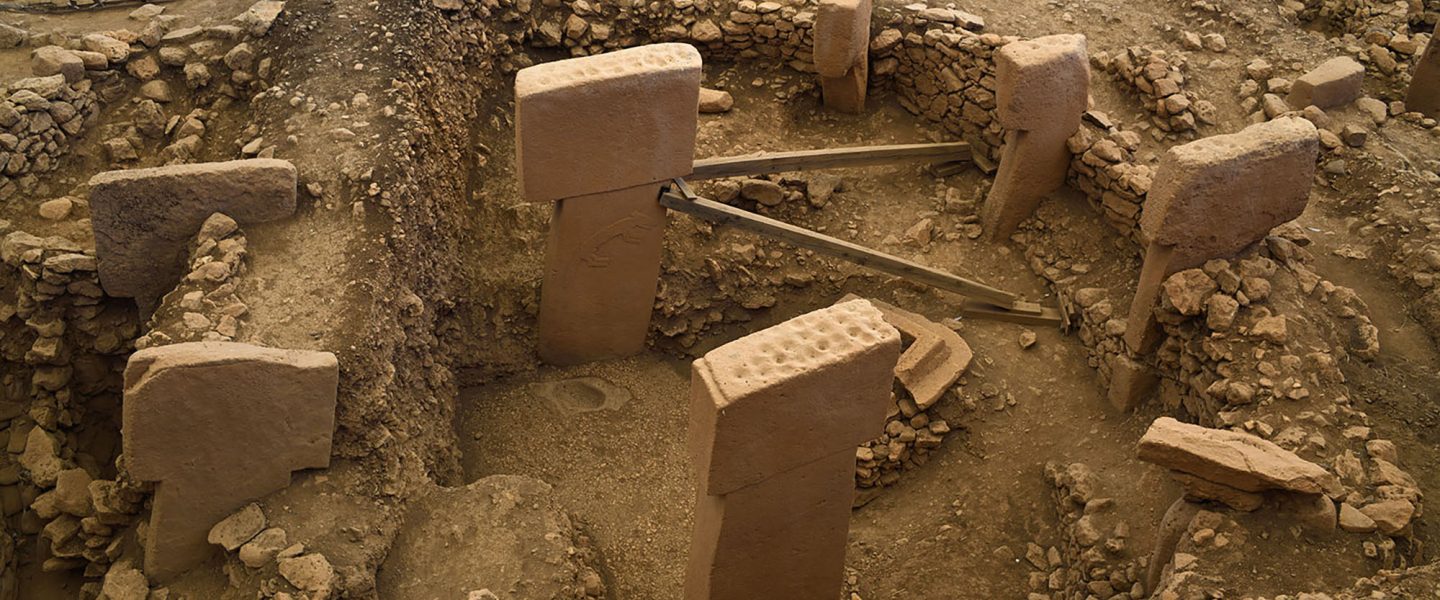Graham Hancock’s new Netflix series is deeply problematic. Figuring out why is an entertaining lesson.
|
Listen To This Story
|
In Ancient Apocalypse, his new Netflix series, Graham Hancock develops his thesis of a lost “high” civilization. As he proposed in his bestseller The Fingerprints of the Gods (1995) and subsequent works, this advanced, global civilization was located on what is now Antarctica, apparently completely wiped away by massive floods, “earth crust displacement,” and an ice age over 12,000 years ago. A few survivors of this civilization then went around the world at the end of the ice age, bringing aspects of their knowledge system to more primitive hunter-gatherers. In past works, Graham identified this lost civilization as Atlantis, the lost city-state mentioned by Plato.
Ancient Apocalypse is a monster hit right now. Many of my friends love the series, raving about it on Instagram and Facebook.
Hancock taps into a deep intuition shared by many of us that the “official story” of our species’s history is incomplete and that something very important — even the most crucial thing — has been hidden from us. He stridently propounds the unsubstantiated thesis that what has been hidden is a literal lost civilization annihilated 12,000 years ago, leaving no trace. In my work, I propose, instead, that what we have lost is not a physical civilization we can find and excavate, but a different kind of consciousness, knowledge, or state of being that is outside time, space, and history as we currently know and conceive it.
This is why I remain fascinated with thinkers such as Rudolf Steiner (who I will write about again soon) and Jean Gebser: They help us define this past condition, and point to our potential of accessing and reintegrating this lost consciousness, which might take us beyond what was attained in the past. Many ancient sites reveal aspects of this other consciousness to us. They help us understand how these past cultures approached the deepest metaphysical and phenomenological questions.
Part of what makes me sad about Ancient Apocalypse is that Hancock’s focus on an idea that seems ultimately misguided makes it impossible for him to explore what is magnificent and still deeply mysterious about many of these ancient sites. To take an example: A site like Teotihuacán in Mexico is an unbelievable achievement, constructed with mathematical precision, for reasons we simply do not understand as of yet. Perhaps, as a side benefit, Ancient Apocalypse will spark more interest in our ancient legacy.
Graham and I have been friends for many years. He has been helpful and kind to me in the past. Years ago, we collaborated on a few retreats together in Utah. For the last few weeks, I have been contemplating how best to respond to the series. Generally, I feel a responsibility to the truth as I understand it, even when this truth is unpopular or causes me hardship. I am also not perfect, make mistakes, and try to admit to them when they are revealed. I still appreciate Graham very much, and do not mean this to be a personal attack.
I am not pretending to know the ultimate answers here. Like Graham, I am not an archaeologist. I have never dug up an artifact, learned surveying, nor made some paradigm-shifting discovery on an ancient site.
Having stated all of that, I admit I find Graham’s approach in the series — and the mass approval of it — to be troubling. Watching the series has forced me to review some of his past books as well. It has opened up many questions for me.
Ancient Apocalypse employs a dramatic archetypal narrative designed to maximize the viewer’s sympathy for Graham. From the outset, he is portrayed as a courageous outsider, the accidental hero and honest system breaker going against the “establishment.” As a lonely, beleaguered figure, constantly under attack from blinkered mainstream archaeology, he crisscrosses the world’s sacred sites, uncovering the deep structure of ancient history.
We are meant to believe that, unencumbered by academic restraints, Graham sees further into history than all those trapped within the academy — those who spent decades training to be archaeologists, who do their research without the fame or wealth Graham gains from his work (Fingerprints of the Gods, alone, sold over 3 million copies). As he says repeatedly, he is not an archaeologist or a “pseudo-archaeologist,” but a journalist and independent researcher investigating humanity’s origins. What this means in practice is that he gives himself the latitude to cherry-pick from the archeological evidence, promoting any shred of data (and they are the barest of shreds) that might support his thesis and rejecting anything that conflicts with it.
Here are the main problems with the series — and Graham’s thesis — as I see it:
1. His evidence is lacking and his arguments are unconvincing
I probably can’t do better in breaking down the errors in his method than a large number of archaeologists who have been critiquing Ancient Apocalypse online. Here, for example, is what archaeologist Flint Dibble writes on Twitter:
If you look closely, Hancock doesn’t ever present any real evidence. Just a range of negative evidence: endless possibilities and suppositions, untested claims, and many explanations for why there isn’t evidence. …
In the final episode, Hancock & Randall Carlson suggest the flood that ended this worldwide Ice Age civilization was caused by a comet impact that melted the glaciers. Why is there no crater? Because it landed in a glacier, proving the flooding and missing evidence.
One of Hancock’s favorite type of evidence comes from remote sensing. Tools like metal detecting or ground penetrating radar (GPR) that help archaeologists get a sense of what is underground or not visible. But these tools are not foolproof and need “groundtruthing.”
Think about it like this. You have a metal detector and decide to do some remote sensing. You walk across a field and pick up some magnetic signals. Do you automatically conclude that it’s a hoard of treasure?
Same thing with ground penetrating radar. It pulses radar underground and measures the reflected signal. There can be lots of explanations for a reflected signal, and so archaeologists always “groundtruth” their results by excavating a sample. …
In Hancock’s presentation of GPR evidence, none have been groundtruthed. No voids at Gunung Padang etc. He’s basically picked up a confusing signal on a metal detector and made a multi-million dollar Netflix show about how it must be Smaug’s treasure from the Hobbit. …
Hancock makes claims about some of the most famous archaeological sites in the world. Every single site he highlights has been intensively investigated. Archaeologists know a lot about them.
The most important argument that Hancock needs to prove to be right is that all these famous monuments like Cholula or Poverty Point or Ggigantija date to the Ice Age.
He presents a wide variety of arguments based on negative evidence for why he must be right.
One of his most common arguments is that archaeologists themselves have found new evidence showing occupation at some of these sites is older than previously thought.
But in no case does this evidence match his argument. They almost all date thousands of years after the Ice Age.
Hancock argues that archaeologists want to censor his argument. But then why are they publishing new dates for sites when they find them? That’s how we make a scholarly name for ourselves. We come to a new conclusion and argue it with evidence. …
Hancock’s argument is based on “negative evidence.” His “flood” has wiped out the evidence for a lost, advanced civilization, but somehow not all the abundant evidence for actual people who lived at the time. I’m convinced, aren’t you?
2. He doesn’t engage deeply — or at all — with experts who hold divergent views.
The series mostly presents Hancock speaking with other outsiders whose methods are similarly questionable. As Rebecca Onion writes in Slate:
One of the oddest aspects of Ancient Apocalypse is how largely absent these nasty mainstream archaeologists are from its run time. Joe Rogan, who has had Hancock on his podcast multiple times, makes a few appearances, lauding Hancock’s free-thinking ways. The other talking heads are either pro-Hancock or edited to look that way. Michael Shermer, of Skeptic magazine, who debated Hancock on Rogan’s show in 2017, merits a 20-second appearance in which he manages to get across one single argument against Hancock’s theory: “If this civilization existed, where are their trash heaps, where are their homes, where are their stone tools or metal tools, where is the writing?” That’s it — then back to Hancock, the “just asking questions,” the rancor.
3. He comes off as very thin-skinned, emotional, and defensive, unable to differentiate critiques of his ideas from personal attacks.
He repeatedly declaims “the extremely defensive, arrogant, and patronizing attitude of mainstream academia” toward his work. Steph Halmhofer, who studies pseudo archaeology and attacks on indigenous heritage by far-right groups, notes:
It’s about conspiracism and the positioning of Hancock as the victim of a conspiracy. The repeated disparaging remarks about archaeologists and other academics in every episode of Ancient Apocalypse is needed to remind the audience that the alternative past being proposed is true, regardless of the lack of conclusive evidence for it. And the vagueness of who this supposed advanced civilisation was, combined with the credence given to it by being in a Netflix-produced series, is going to make Ancient Apocalypse an easily moldable source for anyone looking to fill in a fantasied mythical past.
The positioning of Graham as a noble, courageous outsider is deeply psychologically compelling for many viewers, who also would like to imagine themselves as fighting against the false narratives of the establishment to uncover deeper, hidden truth.
4. His main ideas are not original and have been repeatedly debunked.
Hancock’s basic thesis is a rephrasing of Ignatius Donnelly’s discredited 19th century work on Atlantis. Donnelly had an unfortunate interest in race science, and promoted the idea, which Hancock parrots, that this lost “high” civilization of wise philosophers who brought culture and knowledge to the post-diluvian primitive world was white-skinned and blue-eyed. I know Hancock is not a racist, but unfortunately we are all prey to deep unconscious biases from the long history of colonialism and Christian superiority. These may subliminally bias what ideas appeal to us.
5. Ancient Apocalypse contributes to the ongoing decline in critical thinking faculties and retraction into delusional fantasies.
By rigidly holding to a thesis that is unsupported by evidence, more an article of belief than a field-test-able hypothesis, Hancock, sadly, contributes to some of the worst tendencies of our time. Above all, he contributes to the deepening mistrust of any form of authority or empirical evidence and the diminishing of critical thinking and reasoning skills. This tendency is leading to ever-growing social fragmentation. This social fragmentation — we see it across many areas — helps the growth of far-right movements, which accelerate societal collapse and global ecocide. Trump, for instance, won the US presidency on a “fake news” platform, arguing that since nobody can be trusted, the most trustworthy person is the one who admits outright that they are lying.
It may seem strange that I am so critical of Graham’s project when my past work covers similar topics and is associated with the New Age fringe. After all, I investigate other dimensions of subtle or psychic reality. I wrote a bestselling book that investigated ancient and indigenous prophecies (I referenced Fingerprints of the Gods in it*). I am also critical of the establishment and have examined many of its blindspots due to reductive materialism and “scientism,” among other problems.
Even so, on my own terms, I always try to be rigorous in how I approach these marginalized and somewhat loaded topics. I tend to agree with Bob Dylan: “To live outside the law, you must be honest.” If you intend to effectively challenge the establishment paradigm or reigning myth, you need to be especially scrupulous. I don’t know if I always succeed in doing so — and that is why I try to stay open to criticism, even when it hurts.
A version of this piece was originally published in Daniel Pinchbeck’s newsletter.
*Here’s what I wrote about Hancock’s thesis in 2012:
The pyramids, glyphs, and artworks left behind by [the classic Mayan] civilization suggest an extraordinary refinement and subtlety of thought — vastly different from the later Aztecs, who, Octavio Paz noted, “confiscated a singularly profound and complex vision of the universe to convert it into an instrument of domination.”
The most celebrated monuments of the Maya include the Temple of Kukulkan (the name of Quetzalcoatl in the Toltec tradition) at Chichen Itza. This nine-step pyramid is four-sided and has 91 steps on each side, with the platform on top equaling 365, the number of days in a solar year. Twice a year, on the spring and fall equinox, the shadow of a serpent appears and undulates along the staircase of the temple for more than three hours, creating a pattern of isosceles triangles similar to that found on local rattlesnakes. Puns on all levels, games played with stone and light, in which architecture and sculpture reflect stellar alignments and yearly cycles, fascinated the Mayan mind.
Acoustics were also of interest to them. Archaeologists have recently discovered that clapping at certain spots around the Temple of Kukulkan produces a sound identical to the chirp of the quetzal bird.
“Among the ancient Maya, it seems, artists and scribes belonged to the very highest stratum of a rigidly ranked society,” wrote Michael Coe. As far as we know, they built their imposing structures with the most rudimentary means, lacking even the wheel. Instead of mining metal for coins, they used cacao beans as currency.
Even a cursory examination of Mayan imagery and myth suggests that this civilization was based on different principles, with a completely alien mind-set, from anything we know today. Whereas our society is fascinated by material accumulation, linear evolution, and technology, the center of the Mayan worldview was a vision of vast cycles or cosmic spirals of time, embodied and expressed by a seething pantheon of extravagant deities, hero-twins, and cosmic monsters.

Trained in shamanic practices and initiatory disciplines, members of the nobility were thought to be able to contact these entities directly. In many sculptures, Mayan leaders emerge from the jaws of writhing vision serpents or grinning demigods that act as portals conveying them between different worlds or planes of reality.
These nonhuman entities required appeasement — sometimes through blood — and could be directly evoked in shamanic trance states.
“For the ancient Maya, human beings released their ch’ulel [soul-stuff] from their bodies when they let their blood. Through bloodletting, they ‘conjured’ (tzak) the way and the ch’u, the ‘companion spirits and gods,’” wrote David Freidel, Linda Schele, and Joy Parker in Maya Cosmos.
The Mayan wizard-king was considered the chief possessor of itz, the cosmic sap or magical liquid of shamans and alchemists — akin or identical to the violet-tinged “translinguistic fluid” sought by the McKennas — which can be used to heal or kill.
It was the task of the rulers to maintain the balance of cosmic forces through their magical powers. The king “was the embodiment of the World Tree of the center,” and his task was one of “world centering.” “A king who controlled creation and the power of the Otherworld was by definition a successful king.”
In the elaborate temple cities of the Maya, the central courts were “the settings for great dance pageants that enabled the lords and their people to travel to the Otherworld to greet the supernatural beings who gave power and legitimacy to the human community,” wrote Friedel and Schele.
A long tradition of alternative archaeology challenges the conventional historical model of the Maya and other pre modern civilizations. These scholars — a group of wide-ranging quality including Graham Hancock, Zecharia Sitchin, Erich von Däniken, Maurice Cotterrel, Robert Bauval, Adrian Gilbert, among others — fixate on the advanced aesthetics, paradoxes, intellectual puzzles, and anomalies that shadow the standardized accounts of the Mayans’ warring dynasties and ecological collapse.
Fanciful interpretations have been offered of the most famous icons of Mayan art, such as the sarcophagus cover of the tomb of K’inich J’anaab Pakal, known as “Pacal the Great,” the seventh-century king of Palenque.
For von Däniken, Lord Pacal was clearly an “ancient astronaut,” operating the controls of some futuristic craft: “This strange being wears a helmet from which twin tubes run backwards. In front of his nose is an oxygen apparatus. The figure is manipulating some kind of controls with both hands.”
For Sitchin, Pacal the Great was part of a vast cosmic plot, in which advanced, inhumane star-beings made their way to Earth for pirate plunder, cloning slaves, and mining for gold.
In Fingerprints of the Gods, Graham Hancock, a former correspondent for The Economist and the Sunday Times and one of the better alternative archaeologists, traversed the globe, exploring hints and clues from Egyptian, Mayan, Olmec, and Hopi artifacts and myths, among others, to make an argument for the existence of a prehistoric civilization that had attained an extraordinary level of science and culture before it was destroyed by a cataclysm.
Hancock was persuaded by evidence suggesting that the civilizations that produced Machu Picchu in Peru, as well as the Sphinx in Egypt, were many thousands of years older than conventional accounts would allow.
He followed the arguments of renegade Egyptologist John Anthony West, who had observed that the earliest monuments of Egypt were their most sophisticated achievements and argued that “Egyptian civilization was not a ‘development,’ it was a legacy.” Hancock thought that these civilizations might have descended from a common predecessor — where Plato wrote of “Atlantis,” Mayan legends tell of “Aztlán,” their ancient home — perhaps located in a once-temperate Antarctica.
Studying the Maya, he was amazed by the “computer-like circuitry” of their calendars, which maintained the exact synodic orbits and stellar conjunctions of Mercury, Venus, Mars, and Saturn; calculated the length of the Earth’s orbit around the Sun and the Moon’s orbit around the Earth with extraordinary precision; and kept track of eclipses.
Hancock proposed that the calendar was a bequest from a technologically advanced civilization of prehistory, and its ultimate purpose was to predict “some terrible cosmic or geological catastrophe” in the year 2012, ending the world. He also thought that the image of Lord Pacal on his sarcophagus, with its “side panels, rivets, tubes and other gadgets,” suggested a “technological device.”
In the conventional archaeological view of this artifact, Pacal is seen to be superimposed on an elaborately decorated “foliated cross” that represents the classic “World Tree” of shamanism, reaching down to the underworld and the land of the dead, and upward to transcendent realms. He is suspended along the “Kuxan Suum,” defined in Maya Cosmos as “the navel of the world … a life-sustaining cord traversing the layers of the cosmos, connecting humanity to the gods, the source of life.” According to Freidel and Schele, contemporary Maya believe this cord “was cut by the Spanish invaders.”





